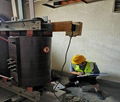Zinc oxide arrester test project 1) Handover test items: insulation resistance, base insulation resistance, action check of discharge counter, leakage current under DC lmA voltage UlmA and 0.75 UlmA, AC leakage current under operation voltage. 2) Routine test items: infrared thermal image detection (precision temperature measurement), continuous current detection in operation, base insulation resistance, discharge counter function inspection. 3) Diagnostic test items: power frequency reference voltage under power frequency reference current, capacitance of equalizing capacitor, DC 1mA voltage (U1mA) and leakage current measurement under 0.75 U1mA. 1. Measuring the Insulation Resistance of Arrester and Base 1) Measuring the insulation resistance of gapless metal zinc oxide arrester can preliminarily determine whether the arrester is damped or not. Measure the base insulation resistance to determine whether the base insulation is good or not. 2) The test method and procedure are based on a megawatt-hour meter of 2500V or more. The insulation resistance of the arrester is measured by a 2500V and above megohm meter. The insulation resistance is recorded for 1 minute. The ground wire is used to fully discharge the two poles of the arrester. 3) Judgment method: no gap metal oxide arrester: 35 kV above, insulation resistance not less than 2500M; 35 kV below, insulation resistance not less than 1000M. Base insulation resistance: self-regulation, can be checked under live condition. 2. Measurement of Leakage Current under DC 1mA Voltage U1mA and 0.75U1mA 1) The test purpose of zinc oxide arrester is to check whether the zinc oxide valve sheet is damp or deteriorated, and to determine whether its performance meets the performance requirements of the product. 2) Test method and procedure of zinc oxide arrester Wipe the surface of lightning arrester porcelain cover clean. High voltage DC generator is used for test wiring (rated voltage of test equipment selected should be higher than DC 1mA voltage of arrester tested), leakage current should be read at high voltage side, and shielded wire should be used for measuring current. Boost. When the leakage current exceeds 200 uA, the voltage will rise a little and the current will increase sharply. Therefore, the step-up speed should be slowed down. When the current reaches 1 mA, the voltage value U1mA will be read and the voltage will drop to zero. Calculate 0.75 times U1mA value. Step up to 0.75U1mA, measure the leakage current, step down to zero and disconnect the test current. When the indication of voltmeter is basically zero, the arrester is discharged by the discharge rod, the grounding wire is hung, and the test wiring is dismantled. A) Clean the surface of the lightning arrester porcelain sleeve. B) High voltage DC generator is used for test wiring (rated voltage of test equipment selected should be higher than DC 1mA voltage of arrester tested), leakage current should be read by side meter at high voltage, and shielding wire should be used for measuring current. C) boost. When the leakage current exceeds 200 uA, the voltage will rise a little and the current will increase sharply. Therefore, the step-up speed should be slowed down. When the current reaches 1 mA, the voltage value U1mA will be read and the voltage will drop to zero. D) Calculate 0.75 times the U1mA value. E) Boost the voltage to 0.75U1mA and measure the leakage current. F) Reduce the voltage to zero and disconnect the test current. G) When the voltmeter indicates that it is basically zero, the arrester is discharged with a discharge rod, the ground wire is hung, and the test wiring is dismantled. H) Recording ambient temperature.




